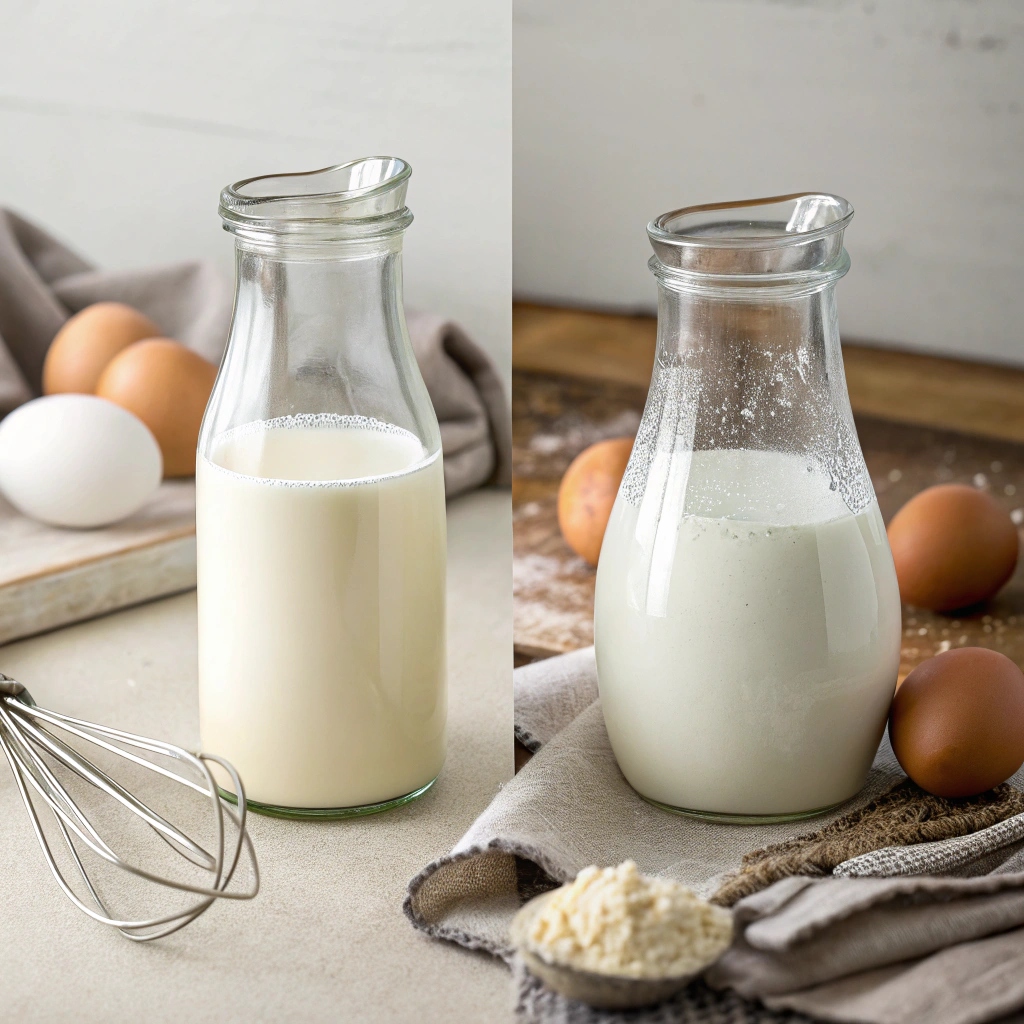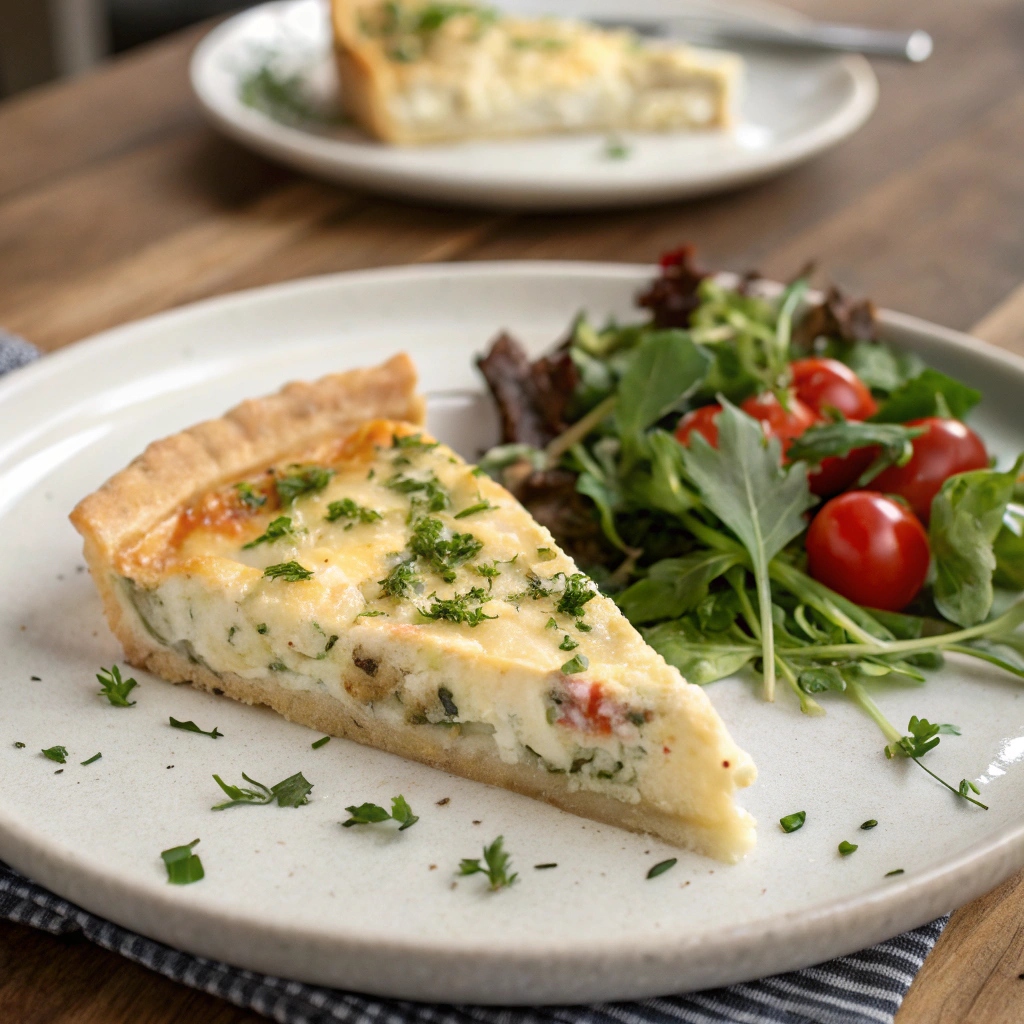Is heavy cream or milk better for quiche? Quiche is like the little black dress of the culinary world – timeless, versatile, and always in style. Whether you’re hosting a fancy brunch, preparing a quick dinner, or looking to impress guests, quiche never fails to deliver. Heavy Cream or Milk Explained But here’s the million-dollar question: What makes quiche so irresistibly creamy and delicious?
If you’ve ever found yourself standing in the dairy aisle, debating whether to grab heavy cream or milk for your quiche, you’re not alone. This dilemma has puzzled home cooks for generations. In this guide, we’ll uncover the secrets behind each option and help you decide which is best for your next masterpiece.
Table of contents
What Makes a Great Quiche?
Before we dive into the heavy cream vs. milk debate, let’s talk about the foundation of a perfect quiche. It’s all about balance. A good quiche has a flaky, buttery crust, a rich and creamy filling, and a perfect blend of flavors. The filling needs to be firm enough to slice but creamy enough to melt in your mouth. This texture is where your choice of dairy plays a starring role.
Understanding the Basics: Heavy Cream vs. Milk
What Is Heavy Cream?
Heavy cream is the heavyweight champion of the dairy world, boasting a rich fat content of around 36-40%. It’s thick, luscious, and the key ingredient in decadent recipes like whipped cream and custards. When it comes to quiche, heavy cream adds a luxurious, velvety texture that screams indulgence.
What Is Milk? Types and Fat Content
Milk, on the other hand, is the lighter contender. With options ranging from whole milk to skim, its fat content can vary from 0% to about 3.5%. While it may lack the richness of heavy cream, milk brings a lighter, airier quality to dishes. It’s perfect if you’re looking to cut calories without sacrificing too much flavor.
“The key difference between heavy cream and milk is fat – and that fat makes all the difference in texture and taste.”
Key Differences Between Heavy Cream and Milk
Here’s a quick breakdown to help you compare the two:
- Fat Content: Heavy cream has significantly more fat than milk.
- Texture: Heavy cream creates a thicker, creamier filling, while milk results in a lighter texture.
- Flavor: Heavy cream brings richness, while milk offers a subtler taste.
- Health Factor: Milk is the healthier choice if you’re watching your fat and calorie intake.

How Each Ingredient Affects Your Quiche
The Impact of Heavy Cream: Richness and Texture
Using heavy cream in your quiche is like wrapping your filling in a silky blanket. It gives your quiche that custard-like consistency, making each bite feel luxurious. If you’re a fan of indulgent flavors and textures, heavy cream is your best friend. But beware – too much can make your quiche overly dense.
Using Milk: A Lighter and Healthier Alternative
Milk, with its lower fat content, creates a lighter quiche. It’s perfect for vegetable-based quiches or when you want to keep things on the healthier side. However, milk alone might leave your quiche lacking in richness. To counter this, consider blending milk with a splash of cream or adding cheese for extra flavor.
“Think of heavy cream as the artist and milk as the canvas – each has its role in creating a masterpiece.”
Combining Heavy Cream and Milk: Best of Both Worlds
Why choose one when you can have both? Many chefs swear by a 50:50 blend of heavy cream and milk. This combination strikes a perfect balance between richness and lightness, giving you a quiche that’s creamy without being too heavy.
Common Problems When Choosing Between Heavy Cream and Milk
Let’s face it – quiche-making isn’t always smooth sailing. One wrong move, and you’re left with a texture that’s more “scrambled eggs” than creamy custard. But don’t worry – we’ve got your back! Here are some common problems and how to avoid them.
Quiche Too Dense: Heavy Cream Overload
While heavy cream gives your quiche that rich, velvety texture, too much of it can turn your filling into a dense, pudding-like mass. This happens because the high fat content creates a super-thick custard that doesn’t have enough liquid to lighten it up.
How to Fix It:
- Use a mix of heavy cream and milk (50:50 works well).
- Stick to the classic ratio of 1 cup of liquid for every 3-4 eggs.
- Add ingredients like sautéed veggies or lighter cheeses to break up the density.
Quiche Too Watery: Milk Mistakes
On the flip side, using only milk – especially lower-fat options like skim or 1% – can result in a quiche that’s watery or doesn’t set properly. This is because milk lacks the fat needed to create that creamy texture.
How to Fix It:
- Use whole milk or combine milk with heavy cream.
- Avoid overloading the filling with watery vegetables (like tomatoes or zucchini) unless you cook them first.
- Pre-bake your crust to prevent sogginess.
Achieving the Right Balance of Flavor and Texture
The real magic happens when you strike the perfect balance. Too much cream, and it’s overly rich; too much milk, and it’s bland. Think of it like tuning a guitar – you need the right tension to hit the sweet spot.
Pro Tips:
- Experiment with different ratios until you find your ideal consistency.
- Don’t forget to season! A pinch of nutmeg, a dash of salt, and a sprinkle of pepper go a long way.
- Always let your quiche rest for 10-15 minutes after baking. This allows the filling to set and makes slicing easier.

Popular Quiche Recipes: Exploring Cream and Milk Ratios
Now that you’ve got the basics down, let’s dive into some recipes. Each one highlights a different way to use heavy cream, milk, or both.
Classic Quiche Lorraine: Cream vs. Milk Debate
Quiche Lorraine is the OG of quiches, starring crispy bacon, Gruyère cheese, and a creamy custard filling. Traditionally, this recipe calls for heavy cream, but modern variations often use a mix of cream and milk for a lighter twist.
Ingredients:
- 1 pre-baked pie crust
- 4 large eggs
- ¾ cup heavy cream
- ¾ cup whole milk
- 1 cup Gruyère cheese, shredded
- 6 slices of cooked bacon, crumbled
- Salt, pepper, and a pinch of nutmeg
Directions:
- Preheat your oven to 375°F (190°C).
- In a bowl, whisk together eggs, cream, milk, salt, pepper, and nutmeg.
- Layer the bacon and cheese in the crust, then pour the custard mixture over them.
- Bake for 35-40 minutes or until the center is set. Let it cool slightly before serving.
Vegetable Quiches: Lightness vs. Richness
Vegetable quiches are a great option for those who prefer a lighter meal. However, the challenge here is balancing the moisture from veggies with the creaminess of the custard.
Pro Tip: Pre-cook vegetables like spinach, mushrooms, or zucchini to remove excess water. A mix of milk and cream works best for these recipes, keeping the filling light but flavorful.
Popular Combinations:
- Spinach, feta, and onion
- Zucchini, goat cheese, and thyme
- Mushroom, Swiss cheese, and garlic
Cheese-Based Quiches: Maximizing Creaminess
If you’re a cheese lover, quiches loaded with cheddar, Swiss, or blue cheese will be your go-to. These recipes pair beautifully with heavy cream, which enhances the cheesy goodness without overpowering it.
Tip: Use a sharp or aged cheese for a bolder flavor. And don’t forget to mix some cheese into the custard for an extra layer of creaminess.
Tips for Perfect Quiche Filling Every Time
Making the perfect quiche is as much about technique as it is about ingredients. Here are some foolproof tips to ensure your quiche is a showstopper.
Choosing the Right Eggs-to-Liquid Ratio
The eggs-to-liquid ratio is the backbone of any quiche recipe. Too much liquid, and it won’t set; too many eggs, and it’ll be rubbery.
The Golden Ratio: For every 4 eggs, use 1 cup of liquid (a mix of cream and milk works best).
Seasoning and Complementary Ingredients
A bland quiche is a sad quiche. To avoid this, don’t skimp on seasonings and complementary ingredients.
- Spices: Nutmeg, cayenne, or paprika can add depth.
- Herbs: Fresh parsley, thyme, or chives work beautifully.
- Cheese: Use bold cheeses to enhance the flavor of your custard.
Baking Tips to Prevent Overcooking
Quiches can go from perfectly set to overcooked in a flash. Keep these tips in mind:
- Bake at a moderate temperature (350°F to 375°F).
- Check for doneness by giving the quiche a gentle shake – the center should jiggle slightly.
- Cover the crust edges with foil if they brown too quickly.
“Think of your quiche like a soufflé – treat it gently, and it will reward you with perfection.”
Health Considerations: Which Is Better for You?
When deciding between heavy cream and milk for your quiche, it’s important to think about more than just flavor and texture. Your choice can significantly impact the calorie count and nutritional value of your dish. Let’s break it down.
Calories and Fat: Heavy Cream vs. Milk
Heavy cream is undeniably the richer option, but with richness comes calories and fat. A single cup of heavy cream can pack over 800 calories and 80 grams of fat, making it a less ideal choice if you’re watching your waistline.
Milk, on the other hand, is much lighter. A cup of whole milk contains about 150 calories and 8 grams of fat, while skim milk is virtually fat-free and clocks in at just 90 calories per cup.
The Verdict:
- Choose heavy cream for special occasions or indulgent quiches.
- Opt for milk (or a cream-milk blend) if you’re aiming for a healthier everyday option.
Dairy-Free or Low-Fat Alternatives
If you’re lactose-intolerant, vegan, or simply looking to cut down on fat, there are plenty of alternatives to heavy cream and milk. Here are a few options to try:
- Coconut Milk: A creamy, dairy-free substitute that works well in savory dishes.
- Almond Milk: A lighter alternative, though it may not provide the same richness.
- Cashew Cream: Perfect for a silky texture and mild flavor.
- Oat Milk: A versatile, plant-based option with a neutral taste.
Pro Tip: Add a tablespoon of cornstarch to these alternatives to thicken your custard if needed.
Expert Opinions: What Do Chefs Recommend?
Is heavy cream or milk better for quiche? When it comes to quiche, professional chefs often have their own tried-and-true techniques. Let’s see what the experts say.
Insights from Pastry Chefs and Home Cooks
Many pastry chefs swear by using a combination of heavy cream and milk. This blend provides the perfect balance of richness and lightness, ensuring a creamy texture without being overly dense. Some chefs also recommend using crème fraîche for a tangy twist.
Home cooks, on the other hand, often prefer the convenience and affordability of milk. Whole milk paired with flavorful cheeses can create a quiche that’s just as satisfying as one made with heavy cream.
“The key to a great quiche is understanding your audience. Want to impress at brunch? Go for heavy cream. Making a quick weeknight dinner? Milk does the job beautifully.” – Chef Ana Ramirez
Cultural Variations in Quiche-Making
Different regions have their own take on quiche, which influences the choice of dairy.
- French Quiche: Traditionally rich and indulgent, often using heavy cream.
- American Quiche: More versatile, with a mix of cream and milk depending on preferences.
- Vegetarian Quiche: Often lighter, using milk or dairy-free options to complement fresh vegetables.
More Ideas for Related Articles
Here’s a professionally structured “More Ideas” section, designed to engage readers and encourage them to explore additional content. Internal links are included naturally, with clear descriptions to ensure relevance to the main topic.
Explore More Quiche Recipes and Tips
- Best Spinach and Ham Quiche Recipe: Easy, Delicious, and Nutritious
Love quiches? This recipe combines savory ham and fresh spinach for a wholesome dish that’s perfect for brunch or dinner. Learn step-by-step instructions and tips to master this classic quiche. - Does Spinach Need to Be Cooked Before Putting in Quiche?
Wondering if you need to prep your spinach before tossing it into your quiche? This article covers the pros and cons of cooking spinach and how it affects texture and flavor.
Dairy and Cream Tips for Other Dishes
- What Type of Cream Is Best for Crème Brûlée?
If you’re curious about how different creams impact desserts, this guide will help you choose the best cream for creating a smooth, luxurious crème brûlée. - Secret to Perfect Crème Brûlée
Unlock the secrets behind achieving that perfect caramelized top and creamy custard base with this detailed tutorial.
Easy-to-Make Breakfast Recipes
- Jimmy Dean Breakfast Sandwich Healthy? The Truth About Its Nutrition
Get insights into the nutritional value of Jimmy Dean breakfast sandwiches and discover healthier alternatives or tips for balancing your breakfast. - Microwaving Frozen Breakfast Sandwiches: Quick and Easy Tips
Short on time? Learn how to perfectly microwave frozen breakfast sandwiches for a quick and satisfying meal.
Comfort Foods to Pair with Your Quiche
- Best Sandwich for Potato Soup: Tasty Pairings You’ll Love
Pair your quiche with the perfect sandwich! This guide highlights mouthwatering options to complement your meal. - Old-Fashioned Baked Macaroni and Cheese: Creamy, Cheesy Bliss
Dive into this comfort food favorite that’s creamy, cheesy, and oh-so-satisfying. Perfect as a side dish or main course.
One-Pan Recipes and Quick Meal Ideas
- Chicken Meets Pasta: How to Nail One Pan Dinners
Save time in the kitchen with this one-pan recipe that combines chicken and pasta into a delicious and hassle-free dinner. - Secrets to Making the Best Rotisserie Chicken Pasta
Transform leftover rotisserie chicken into a creamy, satisfying pasta dish that’s perfect for busy weeknights.
Conclusion: Finding Your Perfect Quiche Formula
So, is heavy cream or milk better for quiche? The answer ultimately depends on your preferences, dietary goals, and the occasion.
When to Use Heavy Cream, Milk, or Both
- Use Heavy Cream: When you want a decadent, rich quiche for a special occasion.
- Use Milk: When you’re aiming for a lighter, healthier dish.
- Use Both: When you want the best of both worlds – creamy yet balanced.
Customizing Quiche to Your Taste and Preferences
Quiche is all about experimentation. Whether you’re a fan of rich, indulgent flavors or prefer a lighter, airy texture, there’s no right or wrong way to make this classic dish. Play around with ingredients, try different ratios of cream to milk, and most importantly, have fun in the kitchen.
“Quiche is a canvas, and you’re the artist. Whether you choose heavy cream, milk, or a little of both, every quiche tells its own delicious story.”

Is Heavy Cream or Milk Better for Quiche? The Ultimate Guide
- Total Time: 1 hour 20 minutes
Description
Discover how to make the perfect quiche by learning whether heavy cream or milk is the better choice! This comprehensive guide provides a foolproof quiche recipe that balances creamy richness and a silky texture, with tips to customize the ingredients for your taste. Perfect for brunch, lunch, or dinner, this classic quiche is both elegant and versatile.
Ingredients
Crust:
1 ½ cups (190g) all-purpose flour
½ teaspoon salt
½ cup (115g) cold unsalted butter, cubed
3–4 tablespoons ice-cold water
Filling:
4 large eggs
1 cup heavy cream (or substitute with whole milk for a lighter texture)
½ cup whole milk (or substitute with heavy cream for extra richness)
1 cup shredded Gruyère cheese (or your preferred cheese)
1 cup cooked and chopped vegetables (e.g., spinach, mushrooms, or broccoli)
½ cup cooked bacon or ham (optional)
½ teaspoon salt
¼ teaspoon black pepper
¼ teaspoon ground nutmeg (optional, for a hint of warmth)
Instructions
Prepare the crust:
In a large bowl, whisk together the flour and salt.
Add cold butter and cut it into the flour using a pastry cutter or your fingers until the mixture resembles coarse crumbs.
Gradually add ice water, 1 tablespoon at a time, mixing until the dough just comes together.
Form the dough into a disk, wrap it in plastic wrap, and refrigerate for at least 30 minutes.
Preheat the oven:
Set your oven to 375°F (190°C).
Blind-bake the crust:
Roll out the chilled dough on a lightly floured surface to fit a 9-inch pie dish.
Gently press the dough into the dish, trimming any excess.
Line the crust with parchment paper and fill with pie weights or dried beans.
Bake for 10–12 minutes. Remove the weights and bake for another 5 minutes until lightly golden. Set aside to cool.
Prepare the filling:
In a medium bowl, whisk together the eggs, heavy cream, milk, salt, pepper, and nutmeg (if using) until smooth.
Stir in the cheese, vegetables, and cooked meat (if using).
Assemble the quiche:
Pour the filling into the partially baked crust, spreading it evenly.
Place the quiche on a baking sheet for easy handling.
Bake the quiche:
Bake for 35–40 minutes, or until the filling is set and slightly golden on top.
Let the quiche cool for 10–15 minutes before slicing and serving.
Notes
For a richer texture, use all heavy cream instead of a combination of milk and cream.
Add your favorite herbs, such as thyme or chives, for extra flavor.
To make the quiche vegetarian, omit the meat and add more vegetables like bell peppers or onions.
Store leftovers in an airtight container in the refrigerator for up to 3 days. Reheat gently in the oven or microwave.
- Prep Time: 30 minutes
- Cook Time: 50 minutes
- Cuisine: French
Nutrition
- Serving Size: 6 servings
Keywords: quiche recipe, quiche with heavy cream, quiche with milk, easy quiche recipe, brunch ideas, creamy quiche
